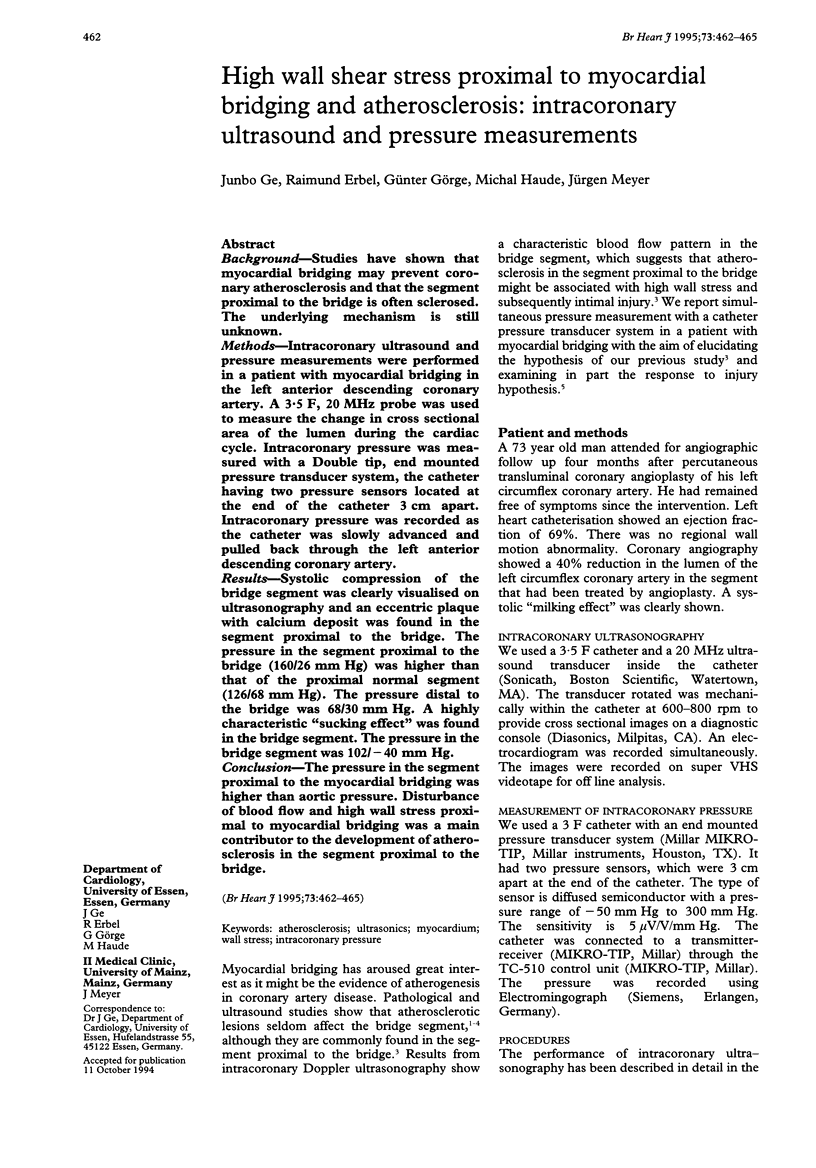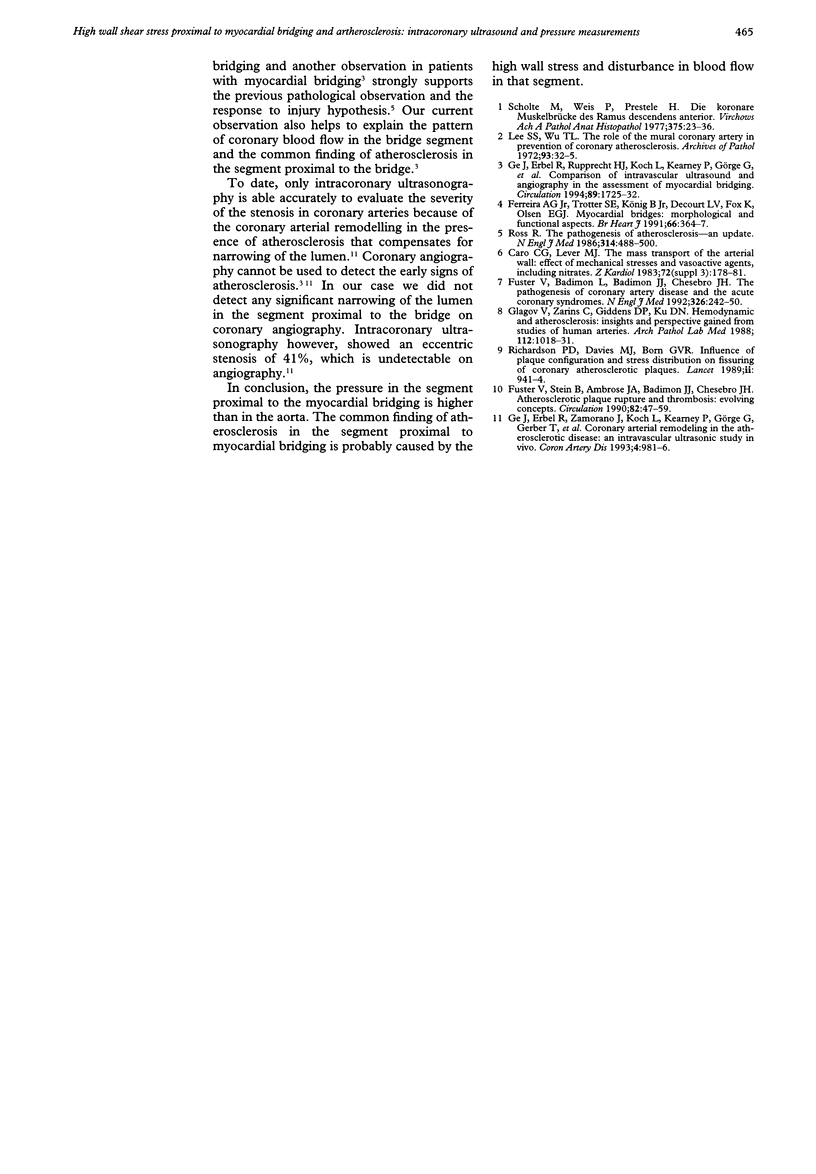Abstract
BACKGROUND--Studies have shown that myocardial bridging may prevent coronary atherosclerosis and that the segment proximal to the bridge is often sclerosed. The underlying mechanism is still unknown. METHODS--Intracoronary ultrasound and pressure measurements were performed in a patient with myocardial bridging in the left anterior descending coronary artery. A 3.5 F, 20 MHz probe was used to measure the change in cross sectional area of the lumen during the cardiac cycle. Intracoronary pressure was measured with a Double tip, end mounted pressure transducer system, the catheter having two pressure sensors located at the end of the catheter 3 cm apart. Intracoronary pressure was recorded as the catheter was slowly advanced and pulled back through the left anterior descending coronary artery. RESULTS--Systolic compression of the bridge segment was clearly visualised on ultrasonography and an eccentric plaque with calcium deposit was found in the segment proximal to the bridge. The pressure in the segment proximal to the bridge (160/26 mm Hg) was higher than that of the proximal normal segment (126/68 mm Hg). The pressure distal to the bridge was 68/30 mm Hg. A highly characteristic "sucking effect" was found in the bridge segment. The pressure in the bridge segment was 102/-40 mm Hg. CONCLUSION--The pressure in the segment proximal to the myocardial bridging was higher than aortic pressure. Disturbance of blood flow and high wall stress proximal to myocardial bridging was a main contributor to the development of atherosclerosis in the segment proximal to the bridge.
Full text
PDF



Selected References
These references are in PubMed. This may not be the complete list of references from this article.
- Caro C. G., Lever M. J. The mass transport of the arterial wall: effect of mechanical stresses and vasoactive agents, including nitrates. Z Kardiol. 1983;72 (Suppl 3):178–181. [PubMed] [Google Scholar]
- Fuster V., Badimon L., Badimon J. J., Chesebro J. H. The pathogenesis of coronary artery disease and the acute coronary syndromes (1). N Engl J Med. 1992 Jan 23;326(4):242–250. doi: 10.1056/NEJM199201233260406. [DOI] [PubMed] [Google Scholar]
- Ge J., Erbel R., Rupprecht H. J., Koch L., Kearney P., Görge G., Haude M., Meyer J. Comparison of intravascular ultrasound and angiography in the assessment of myocardial bridging. Circulation. 1994 Apr;89(4):1725–1732. doi: 10.1161/01.cir.89.4.1725. [DOI] [PubMed] [Google Scholar]
- Ge J., Erbel R., Zamorano J., Koch L., Kearney P., Görge G., Gerber T., Meyer J. Coronary artery remodeling in atherosclerotic disease: an intravascular ultrasonic study in vivo. Coron Artery Dis. 1993 Nov;4(11):981–986. doi: 10.1097/00019501-199311000-00005. [DOI] [PubMed] [Google Scholar]
- Glagov S., Zarins C., Giddens D. P., Ku D. N. Hemodynamics and atherosclerosis. Insights and perspectives gained from studies of human arteries. Arch Pathol Lab Med. 1988 Oct;112(10):1018–1031. [PubMed] [Google Scholar]
- Lee S. S., Wu T. L. The role of the mural coronary artery in prevention of coronary atherosclerosis. Arch Pathol. 1972 Jan;93(1):32–35. [PubMed] [Google Scholar]
- Richardson P. D., Davies M. J., Born G. V. Influence of plaque configuration and stress distribution on fissuring of coronary atherosclerotic plaques. Lancet. 1989 Oct 21;2(8669):941–944. doi: 10.1016/s0140-6736(89)90953-7. [DOI] [PubMed] [Google Scholar]
- Ross R. The pathogenesis of atherosclerosis--an update. N Engl J Med. 1986 Feb 20;314(8):488–500. doi: 10.1056/NEJM198602203140806. [DOI] [PubMed] [Google Scholar]
- Stolte M., Weis P., Prestele H. Die koronare Muskelbrücke des Ramus descendens anterior. Virchows Arch A Pathol Anat Histol. 1977 Aug 9;375(1):23–36. doi: 10.1007/BF00430642. [DOI] [PubMed] [Google Scholar]


